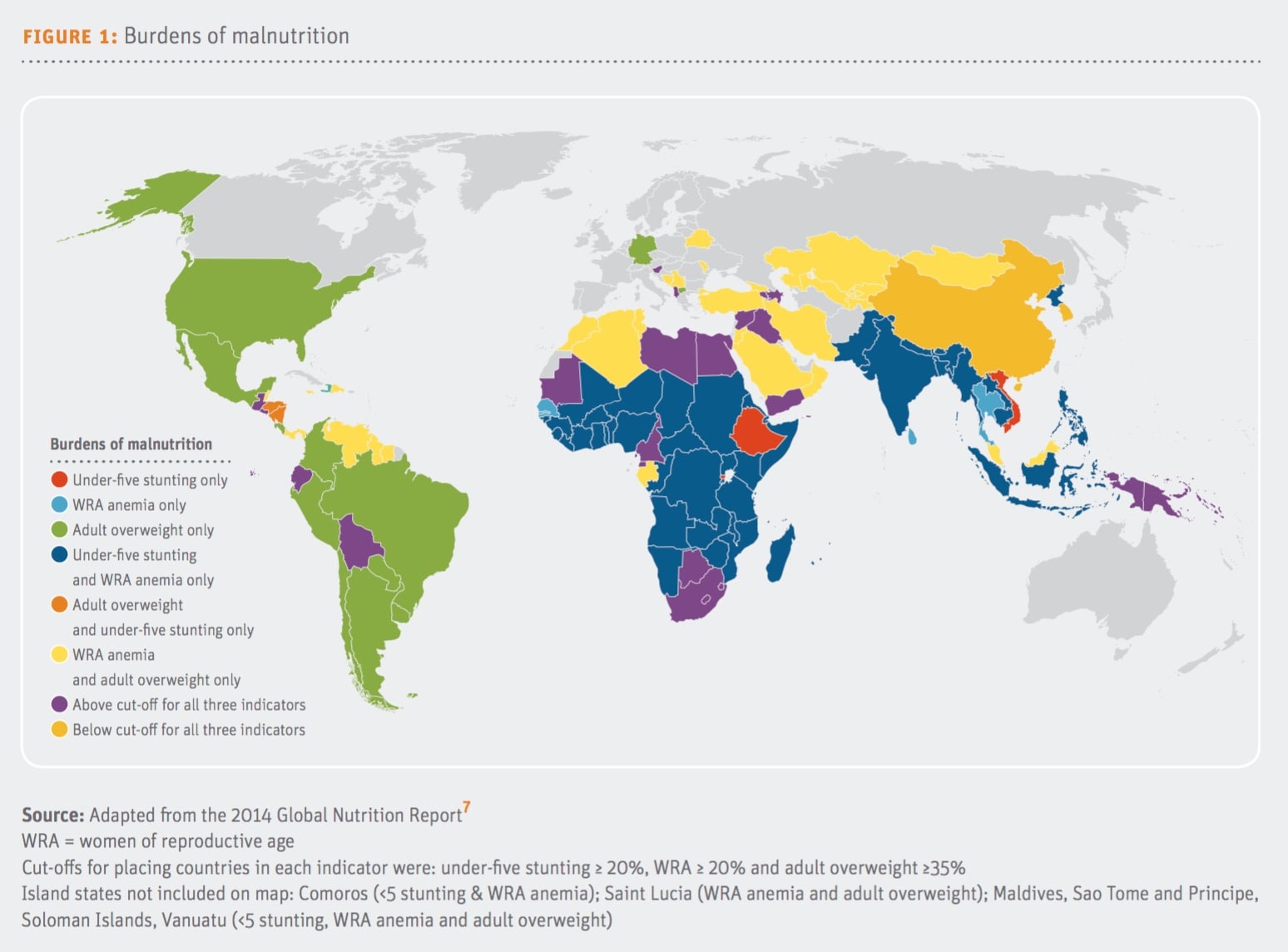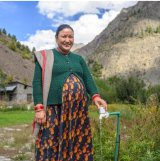The Double Burden of Malnutrition

Increasingly those in the global nutrition arena are discussing challenges presented by the double burden of malnutrition (DBM), a concept first discussed in 1992 at the International Conference on Nutrition (ICN) held by the Food and Agriculture Organization (FAO) and the World Health Organization (WHO). The concept refers to the coexistence of undernutrition and overnutrition in the same population across the life course.
There are over two billion people worldwide who are overweight or obese while at the same time undernutrition persists, sometimes within the same country, city or household.”
– Shauna Downs, Institute of Human Nutrition & Earth Institute, Columbia University
Many governments are now challenged with having populations that are subject to both nutrient “excesses” and “deficiencies”. Undernutrition is not only a phenomenon of low- and middle-income countries (LMICS), and overnutrition is not just a rich country’s problem (Kolčić, 2012).
Currently, two billion people are overweight or obese, one-third of the population still suffers from iodine deficiency, 40 percent of women of reproductive age have anemia, and 17 percent of preschool children are underweight (UNSCN 2010). Increasingly these conditions occur at the same time in the same population, in the same household, and even in the same individual (FAO 2006).
The below graphic was featured in the article, “The Multiple Burdens of Malnutrition“, from the Sight and Life magazine focused on Food Systems and highlights these coexisting dynamics.
There is gathering evidence that when economic conditions improve, obesity and diet related non-communicable diseases may escalate in countries with high levels of undernutrition. There is also evidence to indicate that undernutrition in utero and early childhood may predispose individuals to greater susceptibility to some chronic diseases (Shrimpton and Rokx, 2012).
The scale of the global problem continues to increase, with few examples of the trend reversing or even reducing. This will be further challenged in coming years by an increasingly urban population. In just two decades, two-thirds of the global population will reside in the urban areas of the current LMICs. People in urban environments are becoming increasingly exposed to relatively cheap energy dense processed foods, access to healthier foods, especially fruits and vegetables, is increasingly difficult and there is reduced energy expenditures due to sedentary occupations and lifestyles, with less opportunity and areas to get adequate exercise (Shrimpton and Rokx, 2012).
The Solution?
The double burden of malnutrition certainly has shared drivers and solutions giving a unique opportunity for combined nutrition responses. The WHO recently launched a policy brief drawing attention to the issue with the aim of encouraging action for cost-effective interventions and policies within the United Nations Decade of Action on Nutrition – and, through this, to contribute to achieving the Sustainable Development Goals of ending all forms of malnutrition (SDG2) and ensuring healthy lives and well-being for all at all ages (SDG3) (WHO, 2017)
Referred to as double-duty actions, these may be interventions, programmes and/or policies, that have the possibility to reduce the risk or burden of both undernutrition (including wasting, stunting and micronutrient deficiency or insufficiency) and overweight, obesity or diet-related NCDs (WHO, 2017)
Double duty can be achieved at three levels: through doing no harm with regard to existing actions on malnutrition; by retrofitting existing nutrition actions to address or improve new or other forms of malnutrition; and through the development of de-novo, integrated actions aimed at the double burden of malnutrition (WHO, 2017)
The challenge for many countries is the absence of positive experiences, evidence and success stories in dealing with the double burden of malnutrition. Convincing governments of the win-win scenario that can be gained by viewing malnutrition more broadly rather than the previous silo approach is a real test for the global nutrition community as realities, constraints and limitations of the country context unfold.
References
- FAO (2006) The double burden of malnutrition, Case studies from six developing countries (Accessed on 17th June 2017)
- Kolčić, I (2012) Double burden of malnutrition: A silent driver of double burden of disease in low– and middle–income countries. J Glob Health. Vol 2(2). Online. (Accessed on 17th June 2017)
- Shrimpton, R and Rokx, C (2012) The double burden of malnutrition – A Review of Global Evidence (Accessed on 17th June 2017)
- WHO (2017) The double burden of malnutrition -Policy brief (Accessed on 17th June 2017)
- UNSCN (2010) This Sixth report on the world nutrition situation (Accessed on 17th June 2017)
Read next
Discover more
News & announcements
Find out what is new at Sight and Life
Multimedia
Explore our videos, podcasts, and infographics






